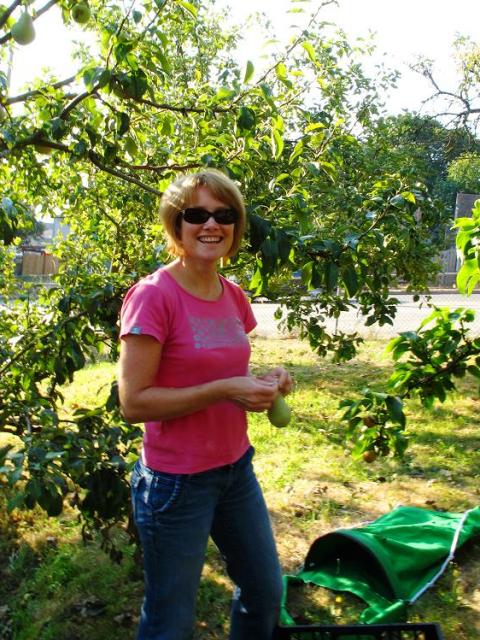Drawing inspiration from Seattle gleaning groups such as Lettuce Link’s Community Fruit Tree Harvest and City Fruit, the PCGP coordinator organized a fruit harvest in five neighborhoods in Tacoma, based on neighborhood council boundaries. While the second year of harvesting fruit trees has reaped more than eight times its first year harvest total, it has not been without challenges. The PCGP gleaning coordinator has learned a lot about organizing a fruit harvest, following the 4 general steps outlined in Solid Ground’s fruit harvest handbook Gather It!: Planning, Laying the Groundwork, Harvesting, and Wrapping Up.
Planning
-
Determine the scope of the fruit tree harvest. PCGP focused on fruit tree harvests in Tacoma, but did arrange harvests in Puyallup (a nearby city) and elsewhere when time permitted.
-
With respect to goals, the PCGP decided to focus on community engagement more than harvesting sheer pounds of fruit.
-
Types of fruit harvested included apples, pears, plums and cherries.
-
Cherries and other highly perishable, hard-to-get fruits are not highly recommended. Many food banks are happy to get wormy or scabby “cooking apples,” but ask food banks ahead of time and try to sort them from good apples. Apples that

fall on the ground cannot be donated (due to the risk of salmonella contamination from animal droppings), but are great for volunteers to take home!
Laying the Groundwork
Community fruit tree harvests essentially connect trees with people, so a large part of organizing the harvest is recruiting volunteers and fruit tree owners.
-
When volunteers sign up in person or online they indicate their interests (farm vs. fruit), whether or not they’d like to be a neighborhood coordinator, and which neighborhoods they are interested in gleaning. That way they’ll receive updates only regarding harvests they may be able to assist.
-
Prospective coordinators were casually interviewed by phone before harvest season and met with the PCGP coordinator and the Jesuit Volunteer to learn how the harvest works and receive tools (handbook, 1-2 picking bags and 1 fruit picker).
-
Other volunteers were encouraged to attend one of two harvest training sessions at public libraries in July, to learn about the project structure, harvesting techniques, and safety.
-
Fruit tree registration in person or online is helpful for planning, but to make a harvest happen, the fruit tree owners call in to the St. Leo’s office when the fruit’s ripe. From there, the St. Leo’s office staff shared information about the fruit tree owners with the gleaning coordinator, who passed the information along to the neighborhood coordinator to set up a harvest.
Harvesting
-
Collect call-in information from your intake center. The PCGP chose St. Leo’s as the call-in center because there is someone answering phones at the St. Leo’s office during regular business hours, while the coordinator is away from her desk too often during harvest season to connect with donor calls.
-
Call the fruit tree owner back to determine a time to check the quality of the tree ahead of harvest, if time permits, and to schedule a harvest.
-
Email the neighborhood volunteers with the prospective harvest time.
-
Once enough volunteers have responded, the harvest is set and the coordinator or neighborhood coordinator drives the tools to the site, oversees the harvest, and donates to the nearest food bank, based on the list of Where to Donate. Helpful tools to bring include:
-
Orchard ladder – if you buy one, buy a 10 ft. ladder. A tall ladder usually works better even on short trees.
-
Fruit pickers
-
Picking bags or backpacks
-
Boxes – milk crates work well.
-
Box labels – It helps to make labels that say “Good,” Cooking,” and “Ground” to binder-clip on your crates as you harvest to keep these types separate.
-
First aid kit
-
Water bottles
-
Eye protection
Wrapping Up
-
Thank the donor by leaving thank you notes for the tree owners
-
Record harvest totals and volunteer hours in a shared Google document. Google docs is a great tool for collaboratively tracking harvest data, but is new to a lot of folks – it is recommended to provide a step-by-step on how to use any Google-based spreadsheet you create.
-
Throw an end-of-season party to thank all involved!

